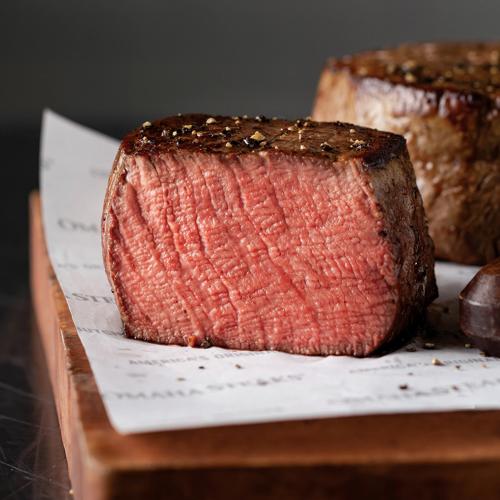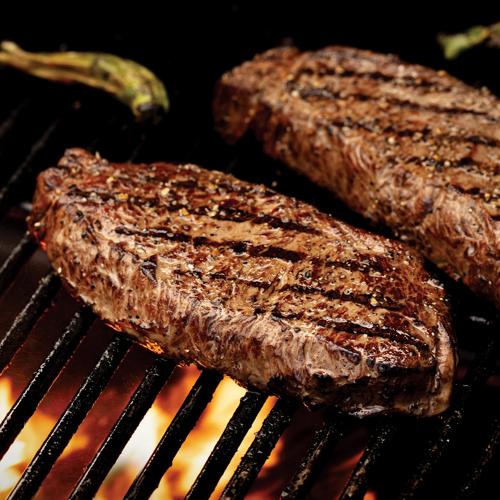Want the secret to cooking a perfect filet mignon? Achieve the perfect steak doneness and a beautiful, brown crust with the reverse-sear steak-cooking method. Whether you’re cooking on the grill or indoors, enjoy a fork-tender, incredible filet mignon in just five simple steps.
What is Reverse Sear?
Reverse sear is a steak cooking method that brings your steak up to temperature low and slow in the oven or on the grill and finishes using high heat.
This method is ideal for thicker steak, like filet mignon, to ensure the steak is cooked to the perfect doneness on the inside and has a beautiful crust on the outside. Reverse sear allows for more control during the cooking method, so you’re less likely to overcook your steak when you follow these 5 simple steps.
Start with Exceptional Filet Mignon
For an incredible filet mignon dinner, it’s critical to start with a phenomenal cut of beef. Omaha Steaks USDA Certified Tender Filet Mignon are hand-selected for the highest quality, aged at least 28 days for maximum tenderness, and expertly trimmed by our master butchers. We offer four cuts of filet mignon – bacon-wrapped, butcher’s cut (double trimmed), triple-trimmed, and Private Reserve. Each cut delivers the fork-tender texture and mild flavor filet mignon connoisseurs love. Before you buy filet mignon you can learn more about each cut in our butcher’s guide.
How to Reverse Sear a Filet Mignon
Step 1: Thaw Completely
Your filet mignon needs to be completely thawed before cooking. You can use one of two thawing methods: in the refrigerator overnight or the quick-thaw method with cold water.
Step 2: Season
Pat steaks dry and season both sides and edges with salt and pepper or Omaha Steaks Seasoning. If you would like to add other seasonings or aromatics, save them for step four. If time allows, we recommend an overnight dry brine to get an extra-crispy crust and a more tender steak. To dry brine, season generously with coarse sea salt on both sides and let the steak rest on a baking rack in the refrigerator for at least one hour or overnight. Once seasoned, allow your steaks to come to room temperature before cooking. This allows the meat to cook more evenly from edge to center.

Step 3: Cook Low & Slow
In the Oven:
Preheat your oven to 250°F. Place your seasoned, room temperature filet mignon on an elevated baking rack for airflow around the beef. Cook for 20-25 minutes in the oven and check temperature using a meat thermometer until the internal temperature is 10°F below your desired doneness. Check every 5-7 minutes until you reach your desired temperature. If you’re aiming for a perfect medium-rare doneness of 130°F, remove the steaks at 120°F. Use the chart below or our steak doneness guide to determine your perfect steak temperature.
On the grill:
Low and slow cooking on the grill requires the use of indirect heat and two cooking zones. On a gas grill, turn on only half of your burners, so that one side of the grill has fire and the other does not. If you have a middle burner, only light one side, not the middle. On a charcoal grill, move all your coals to one side of the grill and leave the other side empty.
Once your grill reaches 225°F-250°F, place your steak over indirect heat as far from the lit side of the grill as possible and close the lid. Although it can be difficult, try to keep your grill temperature between 225°F and 250°F. Your filet mignon will cook slowly via indirect heat and avoids searing the edges. Flip the steak frequently, checking for hot spots. When your steak is 10°F below desired temperature, get ready to sear with direct heat.

Step 4: Sear
On the stove:
When your filet mignon is 10°F below your desired doneness, remove them from the oven and set aside. Heat a cast iron or stainless pan to high on the stovetop. Just before you begin searing your steak, add a small amount of oil that has a high smoke point temperature, like grapeseed oil, ghee, or duck fat. Sear the filet mignon for about 2 minutes per side flipping every 30 seconds to achieve the Maillard reaction on both sides for that beautiful crunchy brown crust.
Filet mignon has less marbling than other steak cuts and a simple compound butter will enhance the mild beef flavors of the meat. Add your butter and any fresh herbs near the end of searing and baste by tilting your pan to the side and spooning the melted butter over the filet mignon.
On the grill:
Sear your filet mignon on a grill by using direct heat. When your steak is 10°F below your desired temperature, place your steak over the hottest part of the grill to sear. Flip constantly, about every 30 seconds, until it’s cooked to your desired doneness with a beautiful crust. Don’t be afraid to also sear the sides of a thicker filet mignon for edge-to-edge perfection.

Step 5: Rest and Enjoy
Allow your steak to rest at least five minutes for the juices to redistribute. Serve your fork-tender filet mignon with a steakhouse side and decadent dessert for an incredible steakhouse-style dinner at home.
More Filet Mignon Cooking Guides:
More Like This

Full Steak Collection
Each steak is aged at least 28 days and hand-carved by master butchers.

18 Steakhouse Recipes
Bring the steakhouse to your house whenever the craving hits with our chef-created recipes.

The Ultimate Guide to Cooking Steak
This guide will give you the confidence to cook the perfect steak indoors or outdoors every time.

Omaha Steaks Filet Mignon
This elegant cut is guaranteed to impress with its exceptional taste and texture.




